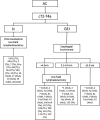History and evidence for state of the art of lymphadenectomy in esophageal cancer surgery
- PMID: 38048446
- PMCID: PMC10987971
- DOI: 10.1093/dote/doad065
History and evidence for state of the art of lymphadenectomy in esophageal cancer surgery
Abstract
The current curative multimodal treatment of advanced esophageal cancers consists of neoadjuvant or perioperative chemo(radio)therapy followed by a radical surgical resection of the primary tumor and a 2- or 3-field lymphadenectomy. One of the most important predictors of long-term survival of esophageal cancer patients is lymph node involvement. The distribution pattern of lymph node metastases in esophageal cancer is unpredictable and depends on the primary tumor location, histology, T-stage and application of neoadjuvant or perioperative treatment. The optimal extent of the lymphadenectomy remains controversial; there is no global consensus on this topic yet. Some surgeons advocate an aggressive and extended lymph node dissection to remove occult metastatic disease, to optimize oncological outcomes. Others promote a more restricted lymphadenectomy, since the benefit of an extended lymphadenectomy, especially after neoadjuvant chemoradiotherapy, has not been clearly demonstrated, and morbidity may be reduced. In this review, we describe the development of lymphadenectomy, followed by a summary of current evidence for lymphadenectomy in esophageal cancer treatment.
Keywords: esophageal cancer; esophagectomy; lymph node; lymphadenectomy; upper GI surgery.
© The Author(s) 2023. Published by Oxford University Press on behalf of International Society for Diseases of the Esophagus.
Conflict of interest statement
MIvBH reports grants from Olympus and Stryker; personal fees from Johnson and Johnson, Medtronic, Mylan and Alesi Surgical. All fees paid to institution outside the submitted work.
The other authors declare that there are no conflicts of interest.
Figures




References
-
- International Agency for Research on Cancer W. Colombia . Globocan 2020. World Health Organization, 2020. https://gco.iarc.fr/today/data/factsheets/populations/170-colombia-fact-....
-
- Kauppila J H, Johar A, Lagergren P. Postoperative complications and health-related quality of life 10 years after esophageal cancer surgery. Ann Surg 2020; 271: 311–6. - PubMed
-
- Ychou M, Boige V, Pignon J P et al. Perioperative chemotherapy compared with surgery alone for resectable gastroesophageal adenocarcinoma: an FNCLCC and FFCD multicenter phase III trial. J Clin Oncol 2011; 29: 1715–21. - PubMed
-
- Gianotti L, Sandini M, Romagnoli S, Carli F, Ljungqvist O. Enhanced recovery programs in gastrointestinal surgery: actions to promote optimal perioperative nutritional and metabolic care. Clin Nutr 2020; 39: 2014–24. - PubMed
-
- Straatman J, van der Wielen N, Cuesta M A et al. Minimally invasive versus open Esophageal resection: three-year follow-up of the previously reported randomized controlled trial: the TIME trial. Ann Surg 2017; 266: 232–6. - PubMed
Publication types
MeSH terms
LinkOut - more resources
Full Text Sources
Medical

